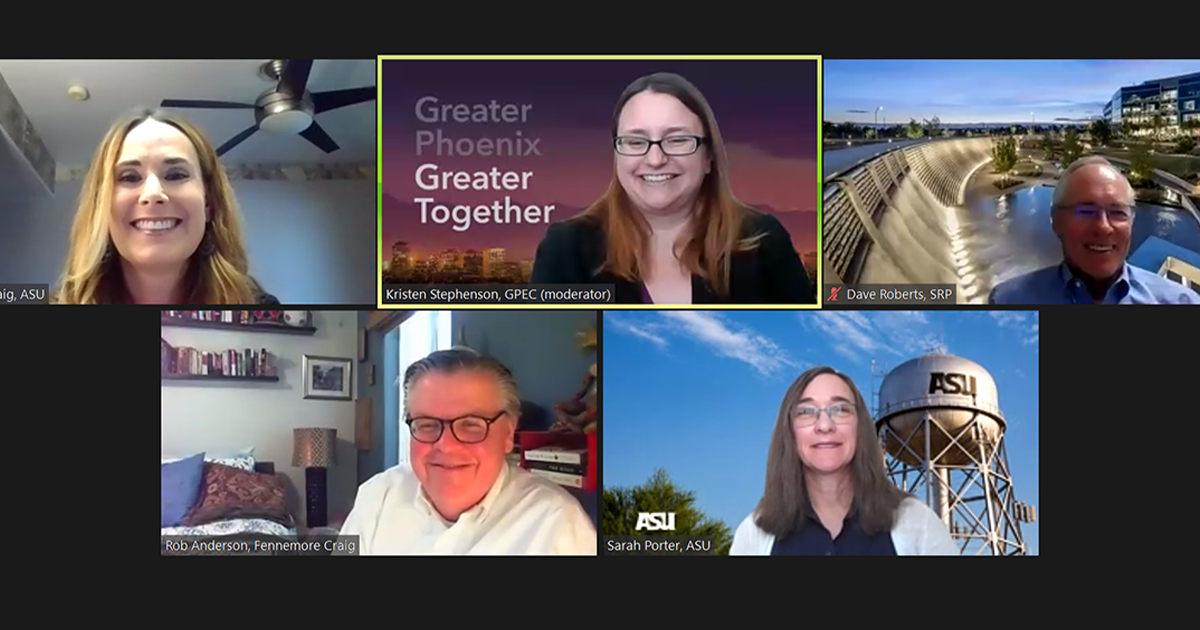

Tracking Arizona’s water
Published: 06/24/2020
Greater Phoenix experts discuss Arizona State University Kyl Center’s new web-based visualization tool; state’s water position
Our most recent GPEC Ambassador Panel featured experts discussing Arizona’s water position and a demonstration of Arizona Water Blueprint, a web-based visualization tool from Kyl Center for Water Policy at Arizona State University’s (ASU).
Panelists included Rob Anderson, director of natural resources, energy, environmental at Fennemore Craig; Susan Craig, water policy analyst for Kyl Center For Water Policy at ASU; Sarah Porter, director of Kyl Center for Water Policy at ASU; and Dave Roberts, associate general manager of water resources at Salt River Project (SRP). The panel was moderated by Kristen Stephenson, our vice president of research and analytics, with more than 85 attendees in the virtual audience for this opportunity offered exclusive to employees of companies that invest in GPEC’s mission.
What is the Arizona Water Blueprint?
The Arizona Water Blueprint offers a data-rich, interactive map of Arizona’s water resources and infrastructure. ASU held workshops with more than 200 experts in water, land use, environmental and economic development including SRP, Tucson Water, City of Phoenix and Arizona Public Service (APS) to develop the tool. ASU’s Kyl Center plans to use the tool to inform policy makers and assist their decision making about water management.
“I think the more data that we make available and the more transparent we are, the better decisions that we’re ultimately going to make,” Susan Craig said.
Both Sarah Porter and Dave Roberts mentioned the tool may be the only one of its kind in the nation.
“Arizona has always been a leader on water data and water management,” Porter said.
What challenges is Arizona facing in water position now and longer term?
Roberts said areas with city development are doing quite well, especially the Phoenix-metro area. However, he mentioned that area could use improvement when it comes to integrating our water supply systems.
“We can trade our water supplies, exchange it, and help others out,” Roberts said. “There are some projects that are being thought of right now to do more of that, so I think that’s great.”
He also pointed to rural areas that are experiencing water challenges.
“We have groundwater overdraft occurring in a lot of areas, and we have litigation occurring as well between environmental uses and uses for water supplies and for people,” he said. “Those are challenges that we’re going to have to pay attention to going forward and come up with creative ways to solve those. That’s what SRP has been about for many years, and we’re looking forward to continuing to help and solve some of those particular issues.”
Rob Anderson stressed the importance of understanding local water issues.
“I think probably the most important thing is that we need to understand as both citizens and businesses in the state is that we need to solve our own water problems,” Anderson says. “We have to make sure that our water supplies are resilient. We have to make sure that we’ve got water for growing in the future and that when somebody asks us a question about water, we can say we’re in a strong position because we managed our water resource well.”
How can residents and businesses ensure Arizona’s water position is competitive and reliable?
The panelists expressed the importance of understanding Arizona’s water for current and future use, and now with access to the Arizona Water Blueprint, this is possible.
“It’s important to become literate about water and [to encourage] elected officials to become aware of water issues,” Porter said.
Roberts said this tool as well as information from municipalities and water providers is also very useful.
“We have to continue to innovate, we have to continue to find ways to make sure that our water supplies can be stretched as far as they can be, and to develop new ones,” he said. “As I mentioned earlier, integrating our water infrastructure is going to be very important in the future to help meet the needs of the citizens that will be coming here to Arizona.”
Are you interested in staying up to date on Greater Phoenix’s growth and advocating for the region’s competitiveness? Become an Ambassador – learn more.